History and Principles of Public Health: A Student Reflection
VerifiedAdded on 2022/11/14
|5
|1195
|444
Report
AI Summary
This report presents a student's reflection on a public health course, focusing on the history, principles, and their application. The student initially questioned the relevance of public health history but later recognized its importance in understanding societal health influences. Key concepts discussed include determinants of health, health inequities, and priority setting, with an emphasis on evidence-based practice and public policy. The student highlights the significance of monitoring and surveillance, evaluation of population health data, and the development of competencies in public health practice. The reflection demonstrates a shift in perspective, emphasizing the practical application of course concepts to future professional roles and the importance of addressing social and economic determinants of health. The student also reflects on the importance of evidence-based practice and public policy in improving community and population health outcomes.
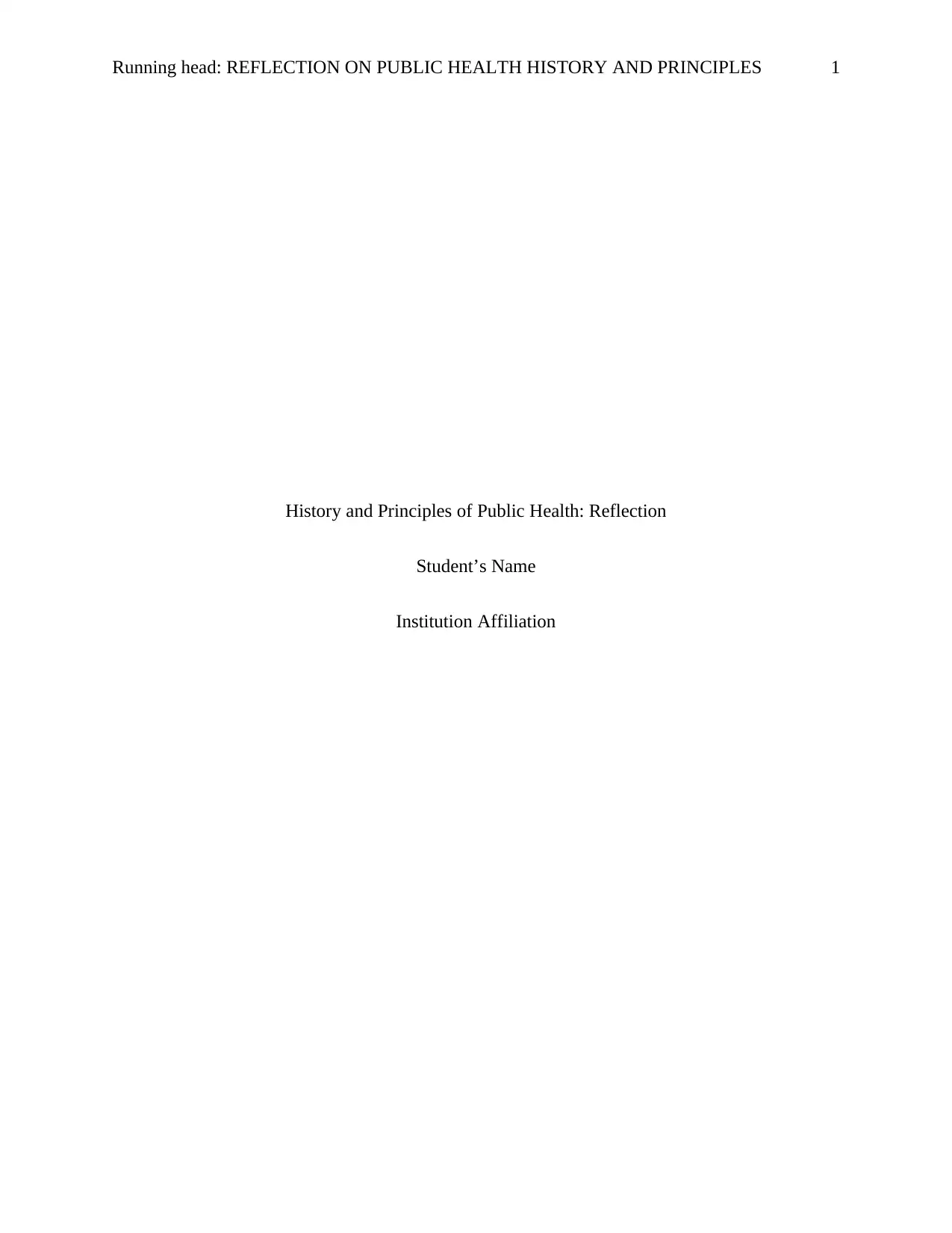
Running head: REFLECTION ON PUBLIC HEALTH HISTORY AND PRINCIPLES 1
History and Principles of Public Health: Reflection
Student’s Name
Institution Affiliation
History and Principles of Public Health: Reflection
Student’s Name
Institution Affiliation
Paraphrase This Document
Need a fresh take? Get an instant paraphrase of this document with our AI Paraphraser
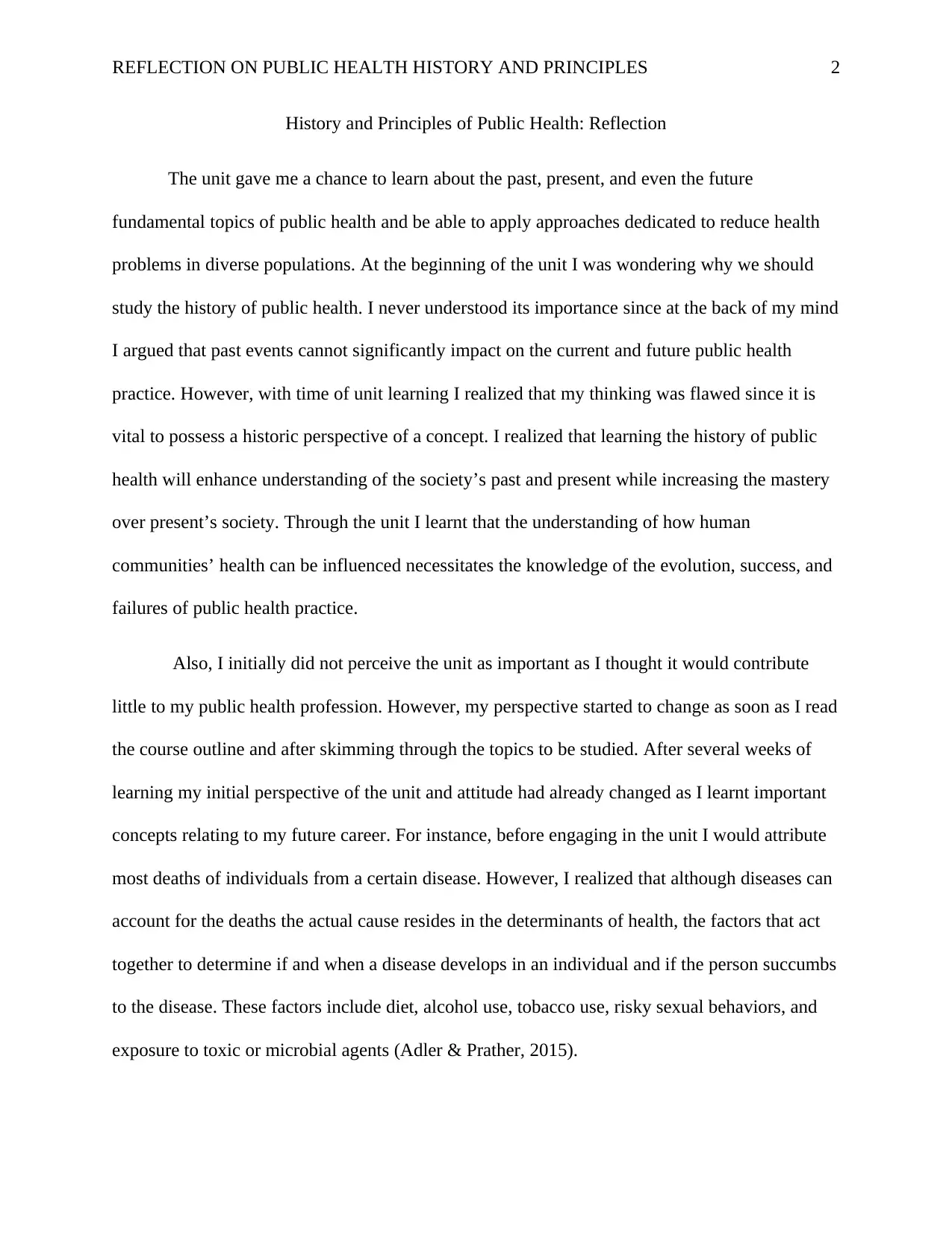
REFLECTION ON PUBLIC HEALTH HISTORY AND PRINCIPLES 2
History and Principles of Public Health: Reflection
The unit gave me a chance to learn about the past, present, and even the future
fundamental topics of public health and be able to apply approaches dedicated to reduce health
problems in diverse populations. At the beginning of the unit I was wondering why we should
study the history of public health. I never understood its importance since at the back of my mind
I argued that past events cannot significantly impact on the current and future public health
practice. However, with time of unit learning I realized that my thinking was flawed since it is
vital to possess a historic perspective of a concept. I realized that learning the history of public
health will enhance understanding of the society’s past and present while increasing the mastery
over present’s society. Through the unit I learnt that the understanding of how human
communities’ health can be influenced necessitates the knowledge of the evolution, success, and
failures of public health practice.
Also, I initially did not perceive the unit as important as I thought it would contribute
little to my public health profession. However, my perspective started to change as soon as I read
the course outline and after skimming through the topics to be studied. After several weeks of
learning my initial perspective of the unit and attitude had already changed as I learnt important
concepts relating to my future career. For instance, before engaging in the unit I would attribute
most deaths of individuals from a certain disease. However, I realized that although diseases can
account for the deaths the actual cause resides in the determinants of health, the factors that act
together to determine if and when a disease develops in an individual and if the person succumbs
to the disease. These factors include diet, alcohol use, tobacco use, risky sexual behaviors, and
exposure to toxic or microbial agents (Adler & Prather, 2015).
History and Principles of Public Health: Reflection
The unit gave me a chance to learn about the past, present, and even the future
fundamental topics of public health and be able to apply approaches dedicated to reduce health
problems in diverse populations. At the beginning of the unit I was wondering why we should
study the history of public health. I never understood its importance since at the back of my mind
I argued that past events cannot significantly impact on the current and future public health
practice. However, with time of unit learning I realized that my thinking was flawed since it is
vital to possess a historic perspective of a concept. I realized that learning the history of public
health will enhance understanding of the society’s past and present while increasing the mastery
over present’s society. Through the unit I learnt that the understanding of how human
communities’ health can be influenced necessitates the knowledge of the evolution, success, and
failures of public health practice.
Also, I initially did not perceive the unit as important as I thought it would contribute
little to my public health profession. However, my perspective started to change as soon as I read
the course outline and after skimming through the topics to be studied. After several weeks of
learning my initial perspective of the unit and attitude had already changed as I learnt important
concepts relating to my future career. For instance, before engaging in the unit I would attribute
most deaths of individuals from a certain disease. However, I realized that although diseases can
account for the deaths the actual cause resides in the determinants of health, the factors that act
together to determine if and when a disease develops in an individual and if the person succumbs
to the disease. These factors include diet, alcohol use, tobacco use, risky sexual behaviors, and
exposure to toxic or microbial agents (Adler & Prather, 2015).
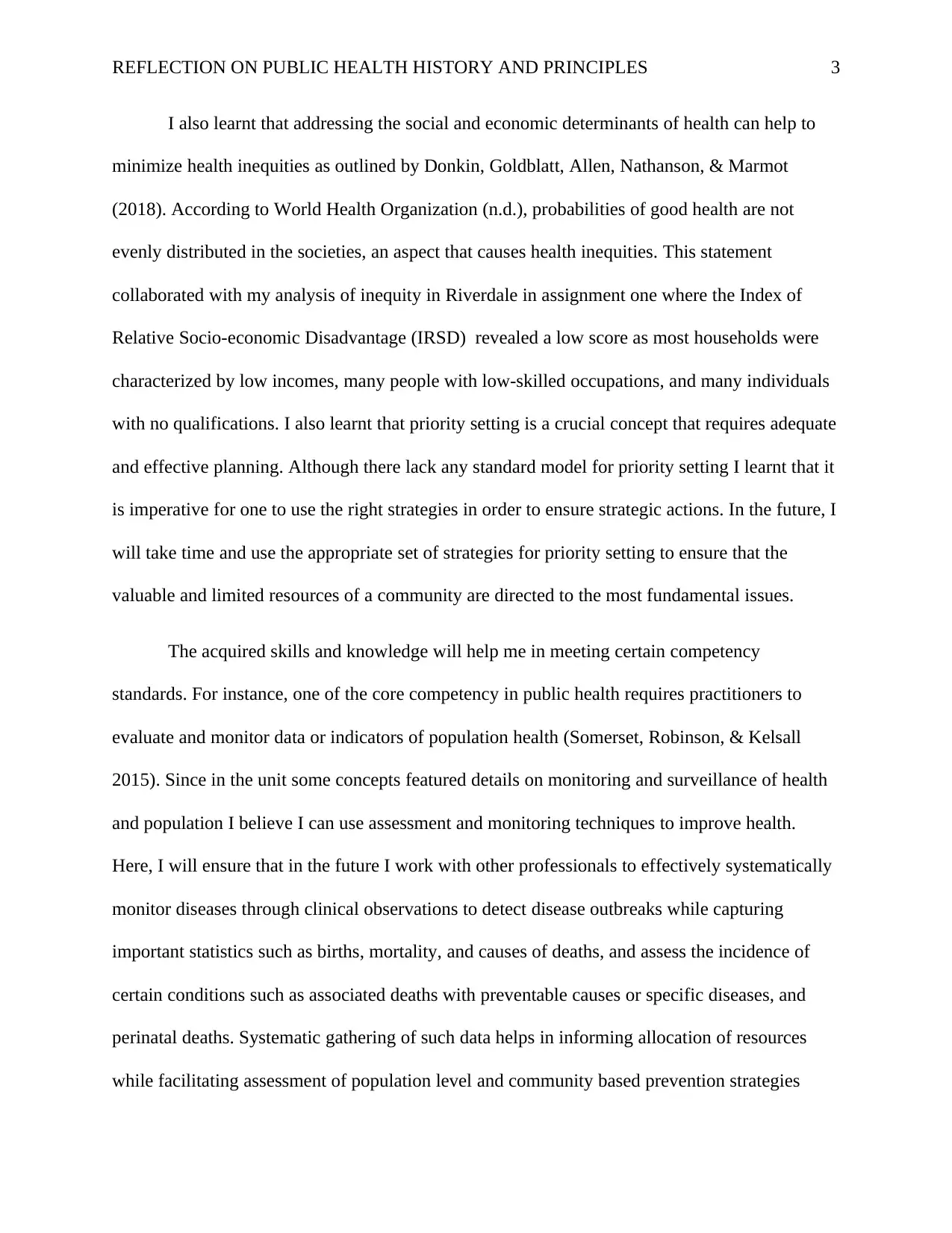
REFLECTION ON PUBLIC HEALTH HISTORY AND PRINCIPLES 3
I also learnt that addressing the social and economic determinants of health can help to
minimize health inequities as outlined by Donkin, Goldblatt, Allen, Nathanson, & Marmot
(2018). According to World Health Organization (n.d.), probabilities of good health are not
evenly distributed in the societies, an aspect that causes health inequities. This statement
collaborated with my analysis of inequity in Riverdale in assignment one where the Index of
Relative Socio-economic Disadvantage (IRSD) revealed a low score as most households were
characterized by low incomes, many people with low-skilled occupations, and many individuals
with no qualifications. I also learnt that priority setting is a crucial concept that requires adequate
and effective planning. Although there lack any standard model for priority setting I learnt that it
is imperative for one to use the right strategies in order to ensure strategic actions. In the future, I
will take time and use the appropriate set of strategies for priority setting to ensure that the
valuable and limited resources of a community are directed to the most fundamental issues.
The acquired skills and knowledge will help me in meeting certain competency
standards. For instance, one of the core competency in public health requires practitioners to
evaluate and monitor data or indicators of population health (Somerset, Robinson, & Kelsall
2015). Since in the unit some concepts featured details on monitoring and surveillance of health
and population I believe I can use assessment and monitoring techniques to improve health.
Here, I will ensure that in the future I work with other professionals to effectively systematically
monitor diseases through clinical observations to detect disease outbreaks while capturing
important statistics such as births, mortality, and causes of deaths, and assess the incidence of
certain conditions such as associated deaths with preventable causes or specific diseases, and
perinatal deaths. Systematic gathering of such data helps in informing allocation of resources
while facilitating assessment of population level and community based prevention strategies
I also learnt that addressing the social and economic determinants of health can help to
minimize health inequities as outlined by Donkin, Goldblatt, Allen, Nathanson, & Marmot
(2018). According to World Health Organization (n.d.), probabilities of good health are not
evenly distributed in the societies, an aspect that causes health inequities. This statement
collaborated with my analysis of inequity in Riverdale in assignment one where the Index of
Relative Socio-economic Disadvantage (IRSD) revealed a low score as most households were
characterized by low incomes, many people with low-skilled occupations, and many individuals
with no qualifications. I also learnt that priority setting is a crucial concept that requires adequate
and effective planning. Although there lack any standard model for priority setting I learnt that it
is imperative for one to use the right strategies in order to ensure strategic actions. In the future, I
will take time and use the appropriate set of strategies for priority setting to ensure that the
valuable and limited resources of a community are directed to the most fundamental issues.
The acquired skills and knowledge will help me in meeting certain competency
standards. For instance, one of the core competency in public health requires practitioners to
evaluate and monitor data or indicators of population health (Somerset, Robinson, & Kelsall
2015). Since in the unit some concepts featured details on monitoring and surveillance of health
and population I believe I can use assessment and monitoring techniques to improve health.
Here, I will ensure that in the future I work with other professionals to effectively systematically
monitor diseases through clinical observations to detect disease outbreaks while capturing
important statistics such as births, mortality, and causes of deaths, and assess the incidence of
certain conditions such as associated deaths with preventable causes or specific diseases, and
perinatal deaths. Systematic gathering of such data helps in informing allocation of resources
while facilitating assessment of population level and community based prevention strategies
⊘ This is a preview!⊘
Do you want full access?
Subscribe today to unlock all pages.

Trusted by 1+ million students worldwide
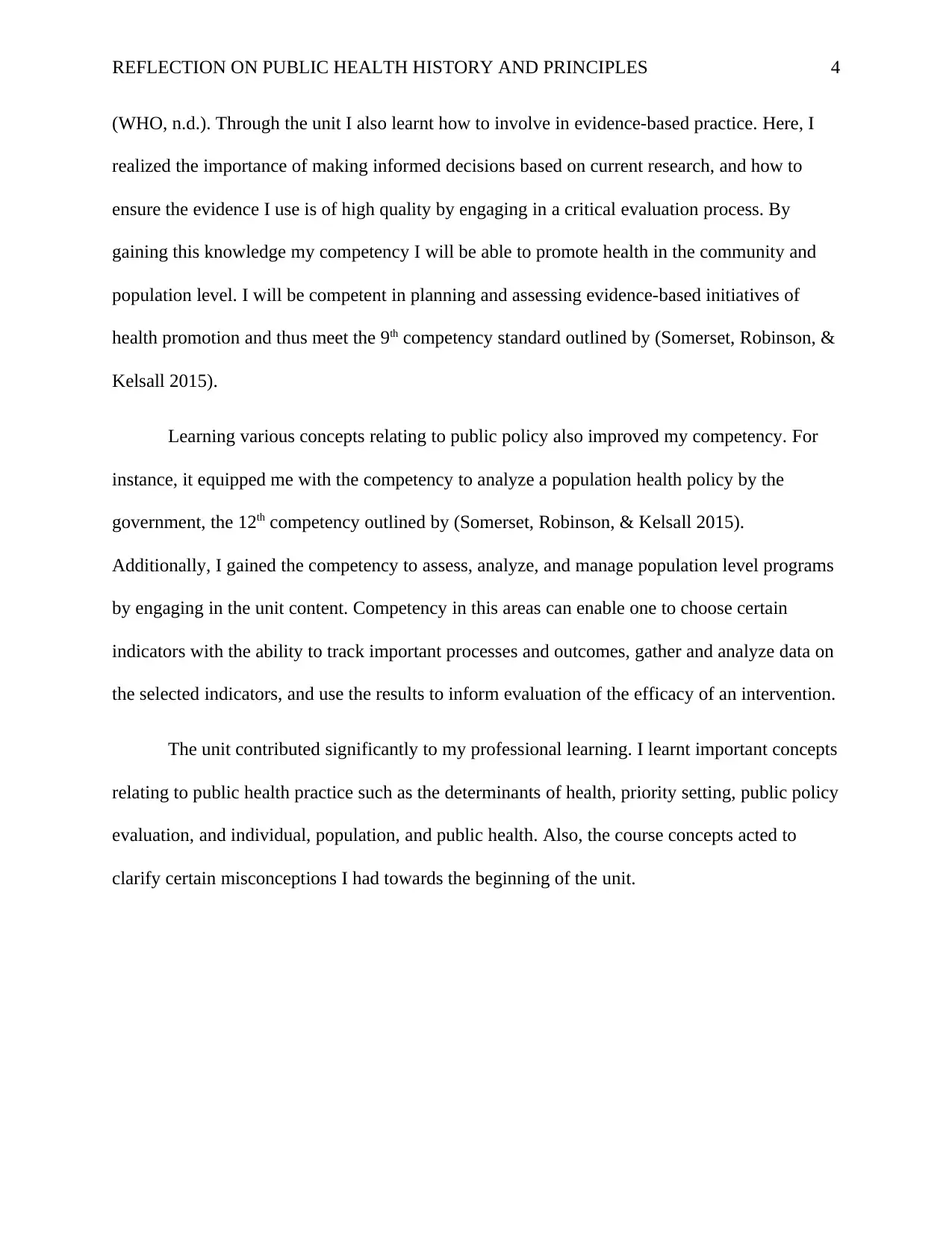
REFLECTION ON PUBLIC HEALTH HISTORY AND PRINCIPLES 4
(WHO, n.d.). Through the unit I also learnt how to involve in evidence-based practice. Here, I
realized the importance of making informed decisions based on current research, and how to
ensure the evidence I use is of high quality by engaging in a critical evaluation process. By
gaining this knowledge my competency I will be able to promote health in the community and
population level. I will be competent in planning and assessing evidence-based initiatives of
health promotion and thus meet the 9th competency standard outlined by (Somerset, Robinson, &
Kelsall 2015).
Learning various concepts relating to public policy also improved my competency. For
instance, it equipped me with the competency to analyze a population health policy by the
government, the 12th competency outlined by (Somerset, Robinson, & Kelsall 2015).
Additionally, I gained the competency to assess, analyze, and manage population level programs
by engaging in the unit content. Competency in this areas can enable one to choose certain
indicators with the ability to track important processes and outcomes, gather and analyze data on
the selected indicators, and use the results to inform evaluation of the efficacy of an intervention.
The unit contributed significantly to my professional learning. I learnt important concepts
relating to public health practice such as the determinants of health, priority setting, public policy
evaluation, and individual, population, and public health. Also, the course concepts acted to
clarify certain misconceptions I had towards the beginning of the unit.
(WHO, n.d.). Through the unit I also learnt how to involve in evidence-based practice. Here, I
realized the importance of making informed decisions based on current research, and how to
ensure the evidence I use is of high quality by engaging in a critical evaluation process. By
gaining this knowledge my competency I will be able to promote health in the community and
population level. I will be competent in planning and assessing evidence-based initiatives of
health promotion and thus meet the 9th competency standard outlined by (Somerset, Robinson, &
Kelsall 2015).
Learning various concepts relating to public policy also improved my competency. For
instance, it equipped me with the competency to analyze a population health policy by the
government, the 12th competency outlined by (Somerset, Robinson, & Kelsall 2015).
Additionally, I gained the competency to assess, analyze, and manage population level programs
by engaging in the unit content. Competency in this areas can enable one to choose certain
indicators with the ability to track important processes and outcomes, gather and analyze data on
the selected indicators, and use the results to inform evaluation of the efficacy of an intervention.
The unit contributed significantly to my professional learning. I learnt important concepts
relating to public health practice such as the determinants of health, priority setting, public policy
evaluation, and individual, population, and public health. Also, the course concepts acted to
clarify certain misconceptions I had towards the beginning of the unit.
Paraphrase This Document
Need a fresh take? Get an instant paraphrase of this document with our AI Paraphraser
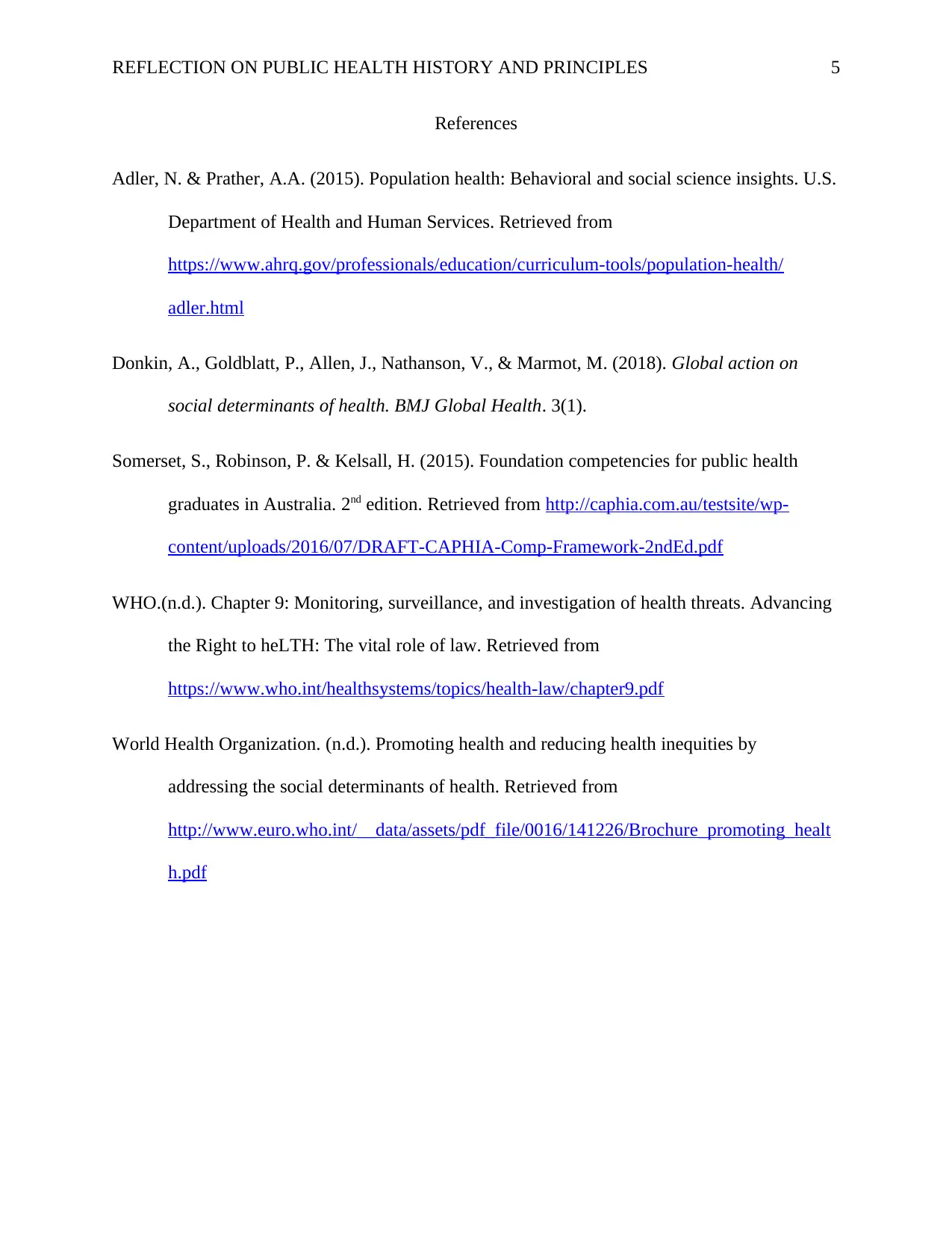
REFLECTION ON PUBLIC HEALTH HISTORY AND PRINCIPLES 5
References
Adler, N. & Prather, A.A. (2015). Population health: Behavioral and social science insights. U.S.
Department of Health and Human Services. Retrieved from
https://www.ahrq.gov/professionals/education/curriculum-tools/population-health/
adler.html
Donkin, A., Goldblatt, P., Allen, J., Nathanson, V., & Marmot, M. (2018). Global action on
social determinants of health. BMJ Global Health. 3(1).
Somerset, S., Robinson, P. & Kelsall, H. (2015). Foundation competencies for public health
graduates in Australia. 2nd edition. Retrieved from http://caphia.com.au/testsite/wp-
content/uploads/2016/07/DRAFT-CAPHIA-Comp-Framework-2ndEd.pdf
WHO.(n.d.). Chapter 9: Monitoring, surveillance, and investigation of health threats. Advancing
the Right to heLTH: The vital role of law. Retrieved from
https://www.who.int/healthsystems/topics/health-law/chapter9.pdf
World Health Organization. (n.d.). Promoting health and reducing health inequities by
addressing the social determinants of health. Retrieved from
http://www.euro.who.int/__data/assets/pdf_file/0016/141226/Brochure_promoting_healt
h.pdf
References
Adler, N. & Prather, A.A. (2015). Population health: Behavioral and social science insights. U.S.
Department of Health and Human Services. Retrieved from
https://www.ahrq.gov/professionals/education/curriculum-tools/population-health/
adler.html
Donkin, A., Goldblatt, P., Allen, J., Nathanson, V., & Marmot, M. (2018). Global action on
social determinants of health. BMJ Global Health. 3(1).
Somerset, S., Robinson, P. & Kelsall, H. (2015). Foundation competencies for public health
graduates in Australia. 2nd edition. Retrieved from http://caphia.com.au/testsite/wp-
content/uploads/2016/07/DRAFT-CAPHIA-Comp-Framework-2ndEd.pdf
WHO.(n.d.). Chapter 9: Monitoring, surveillance, and investigation of health threats. Advancing
the Right to heLTH: The vital role of law. Retrieved from
https://www.who.int/healthsystems/topics/health-law/chapter9.pdf
World Health Organization. (n.d.). Promoting health and reducing health inequities by
addressing the social determinants of health. Retrieved from
http://www.euro.who.int/__data/assets/pdf_file/0016/141226/Brochure_promoting_healt
h.pdf
1 out of 5
Related Documents
Your All-in-One AI-Powered Toolkit for Academic Success.
+13062052269
info@desklib.com
Available 24*7 on WhatsApp / Email
![[object Object]](/_next/static/media/star-bottom.7253800d.svg)
Unlock your academic potential
Copyright © 2020–2025 A2Z Services. All Rights Reserved. Developed and managed by ZUCOL.





